The Evolution of Big Blue
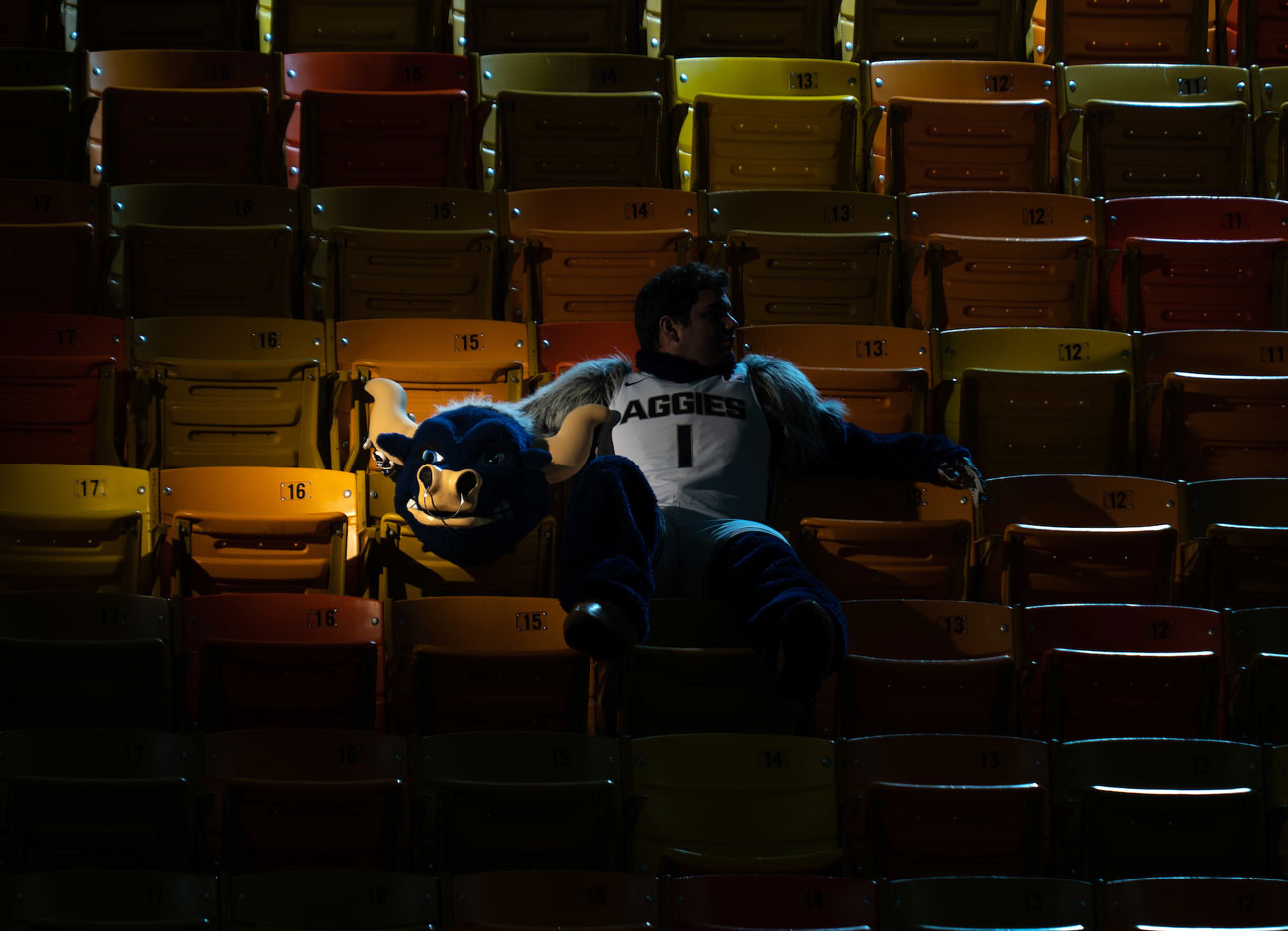
John Mortensen ‘87 has worn at lot of hats during his 30-plus years at Utah State University.
Make that a lot of hats, and at least one very large, fuzzy head.
A native of Logan, Mortensen completed a bachelor’s in finance, followed by a master’s in business information systems, and then he went right into working for his alma mater in a variety of positions, most recently as the assistant vice president for academic and instructional services.
But what Mortensen’s LinkedIn page doesn’t divulge is that he was, arguably, the first-ever Big Blue.
“I was the first one to wear the costume, so technically, I guess,” Mortensen admits while sitting behind the desk in his office in the Taggart Student Center.
“But that’s debatable.”
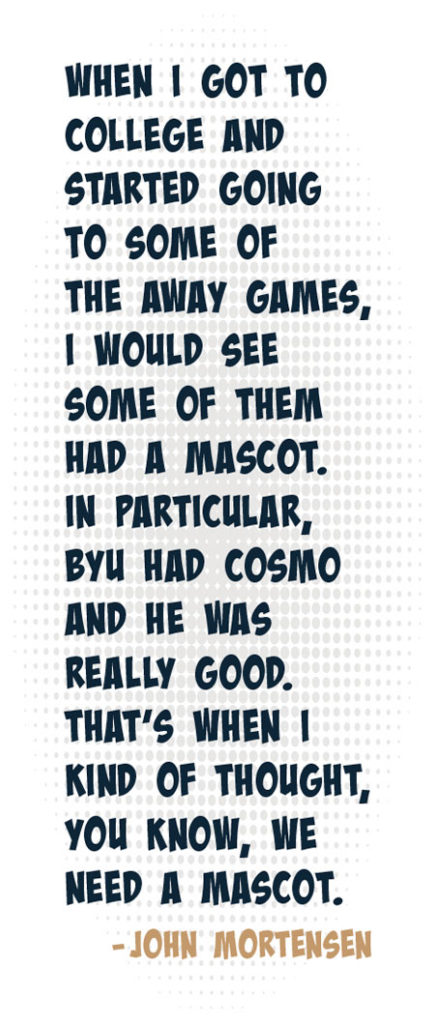
Indeed. If the genesis of Utah State’s beloved mascot was shared like a comic-book origin story, that tale would encompass four years and three very pivotal individuals, including Mortensen.
“Kenn was the first one who owned it and did what it was intended to be,” says Mortensen, referencing Kenn Solomon, who donned the Big Blue costume for the 1989-90 school year. “When Kenn came on, you had that second element. You had someone who could really perform in it.
“But also, at the same time, you had Linda Zimmerman. Because Kenn wouldn’t have been able to take it to that level if he hadn’t had the support of the spirit squad advisor.”
Now the executive director of the university’s Student Leadership & Involvement Center, Zimmerman served as advisor for USU Spirit Squad from 1988 to 2010. When Zimmerman, a former Aggie cheerleader herself, stepped into the role it involved coaching only cheerleaders and Aggiettes. The university had no mascot, although it wasn’t from a lack of trying.
Prior to the start of his senior year, Mortensen was elected student athletics VP, and he saw it as an opportunity to bring an Aggie mascot to life.
“When I got to college and started going to some of the away games, I would see some of them had a mascot. In particular, BYU had Cosmo, and he was really good,” Mortensen recalls. “That’s when I kind of thought, ‘You know, we need a mascot.’”
Back in the mid-1970s, USU experimented with a live animal mascot, a feisty, white bull named GUS — an acronym for “Go Utah State” — who was painted blue before athletic events. But GUS did too much damage to the grass field at Romney Stadium (despite the addition of rubber boots), and he was soon retired. For a time, a Cache Valley radio station also sent the KVNU Chicken — a local take on the famous San Diego Chicken — to perform some antics at Aggie games, but USU never had a mascot akin to Cosmo, Brigham Young University’s mascot who first came to life at a pep rally prior to the Cougars playing Utah State Agricultural College in 1953.
But after finally scraping together $750 for a mascot costume that resembled the drawing of a bull made by a USU student, Mortensen was horrified to see that the shade of blue was, well, too Cosmo-like.
“When I got down to the costume shop in Salt Lake, I was so disappointed because it was royal blue,” Mortensen says with a moan.
While no one apparently knows the location of Big Blue’s original head, Mortensen still has a tiny photograph of it from a Homecoming parade showing its most notable, and potentially dangerous, feature: a real set of bull horns.
“It was a little bit scary looking compared to the current Big Blue. It was basically just a big, H.R. Pufnstuf-type costume,” Mortensen notes, referencing the children’s television program from the late 1960s and early ‘70s.
“I mean, it was a costume. You could give kids a high-five, but you really couldn’t move in it. And if you leaned over, the head would fall off.”
This is something Mortensen knows from experience.
Not only did he walk around campus in the costume a few times, he spent the first quarter of the first home football game that season silently cheering on the Aggies from inside the anonymity of the brand-new suit. Another student, Chris Hawkes, took over later in the game, and wore the Big Blue costume most of that year, changing in the office of USU head coach Chuck Shelton at football games and in a restroom at the Spectrum for basketball games.
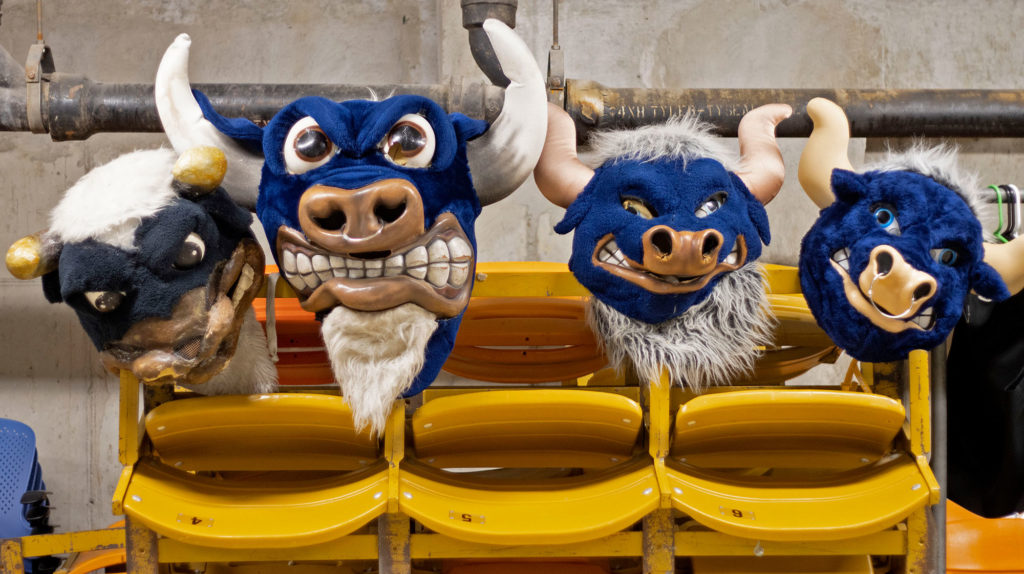
But shortly after the end of the 1986-87 basketball season Mortensen graduated and the $750 costume was relegated to a big cardboard box in the office of the student athletics vice president for the next couple of years.
“I was hoping that was just the start, and it would go to the next level and become something more like Cosmo was, out there with the cheerleaders and being very active and acrobatic,” he says.
“And no one really wanted to own it. At that time, we had separate advisors for cheerleaders and Aggiettes, and they didn’t want anything to do with it. And the next two athletic VPs just didn’t see the use of it.”
A Rocky Start
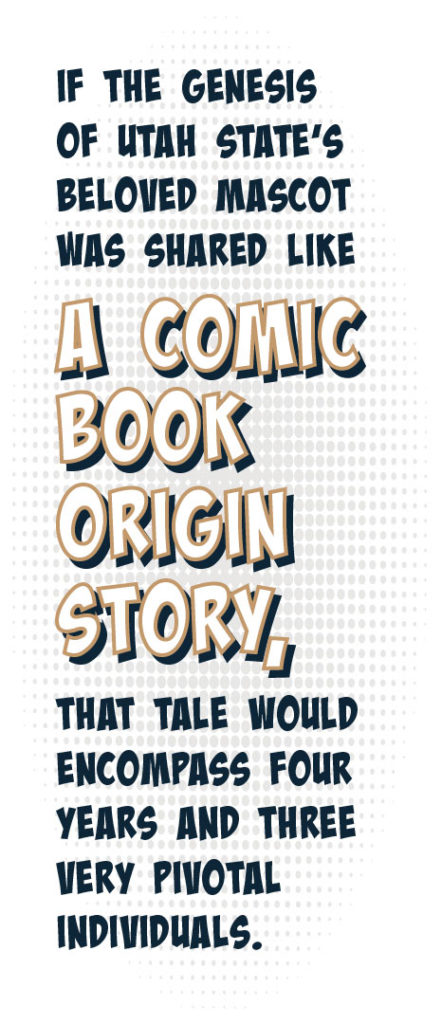
When it comes to stunting in cheerleading, timing is everything. And in the evolution of Big Blue, the hiring of Linda Zimmerman as USU’s spirit squad advisor was just a little off, and yet, still close enough to complete the move thanks to the persistence of Kenn Solomon.
He attended Ricks College — before it became BYU-Idaho — in Rexburg, on a ballroom dancing scholarship before and after serving a mission for the Church of Jesus Christ of Latter-day Saints. It was a two-year junior college, and Solomon was trying to decide where to continue his education when he dialed Zimmerman, who was in the middle of her first full year at Utah State.
“He kept calling me saying, ‘You guys need a mascot. You need a mascot. You really need a mascot,’” Zimmerman recalls. “Finally, I had had it with him calling, and so we decided to take him to California for the basketball tournament.
“And he was amazing,” Zimmerman adds with a whisper for emphasis. “Seeing him in person, he made Big Blue come alive. Gary Chambers, who was the vice president of student affairs then, was like, ‘We’ve got to get this kid.’”
Once it was determined that Solomon would be on scholarship as Utah State’s mascot, Zimmerman and Solomon went to work making alterations, replacing the BYU-like royal blue with navy blue wherever possible and modifying the head so it didn’t fall off so easily. And Solomon, who is about 8 inches shorter than Mortensen, removed the bull hooves and shortened up the legs, not only to accommodate his height, but also so he could wear sneakers and move around more freely.
“Kenn just blew everybody away,” Mortensen says. “He was exactly what I had envisioned when we got the suit in the first place, somebody who could get out there and do things to help energize the crowd and get the fans involved.”
Unfortunately for Utah State, Solomon’s tenure as Big Blue was over after just one school year. In the summer of 1990, while serving an internship at the Rocky Mountain News in Denver, he used the same sort of tenacity that won Zimmerman over on the management of the Denver Nuggets. On Dec. 15, 1990, Solomon made his debut as Rocky, the Nuggets’ mascot, and he became a legend throughout the NBA.
After more than three decades and 18 NBA All-Star Game appearances as Rocky, Solomon retired at the end of 2020-21 season as a hall of famer. In 2008, Rocky was inducted into the Mascot Hall of Fame in Whiting, Indiana, and Solomon currently sits on the hall’s executive committee.
But Solomon wasn’t the only Big Blue to go professional. The first three Big Blues all worked for pro sports organizations after leaving USU.
Solomon’s successor, Gregory Houlton, was Big Blue from 1991 to ’93, then was hired as Icy the Eagle by the Salt Lake Golden Eagles minor league hockey team. Houlton was there for just a year before the franchise was sold, but he managed to retain the rights to Icy and relocated to Indiana where he entertained crowds for the Fort Wayne Komets until 2000. And Jim Maxfield, who was Big Blue from 1993 to ’95, spent a few years in Cleveland as the Cavaliers’ first mascot.
Sweat Equity
Big Blue’s changes over the past three decades are most evident in the head and the suit. The frightening noggin initially worn by John Mortensen and Kenn Solomon was soon replaced with a version without real bull horns. And while an early reincarnation of Big Blue’s suit boasted a very dark blue color, Zimmerman says children responded better to a lighter blue with softer features, and more recent suits reflect that, including having a lighter nose and hooves.
The current Big Blue suits, created by Alinco Costumes in Murray, cost about $3,500, and are quite durable because they get washed. A lot.
“We wash that fur every single time they’re in it,” Zimmerman notes. “We hang it up to dry, and we use a lot of Downey so that he always smells really nice. We take a lot of pride in making sure that he looks almost new all the time.”
Of course, that comes with a price.
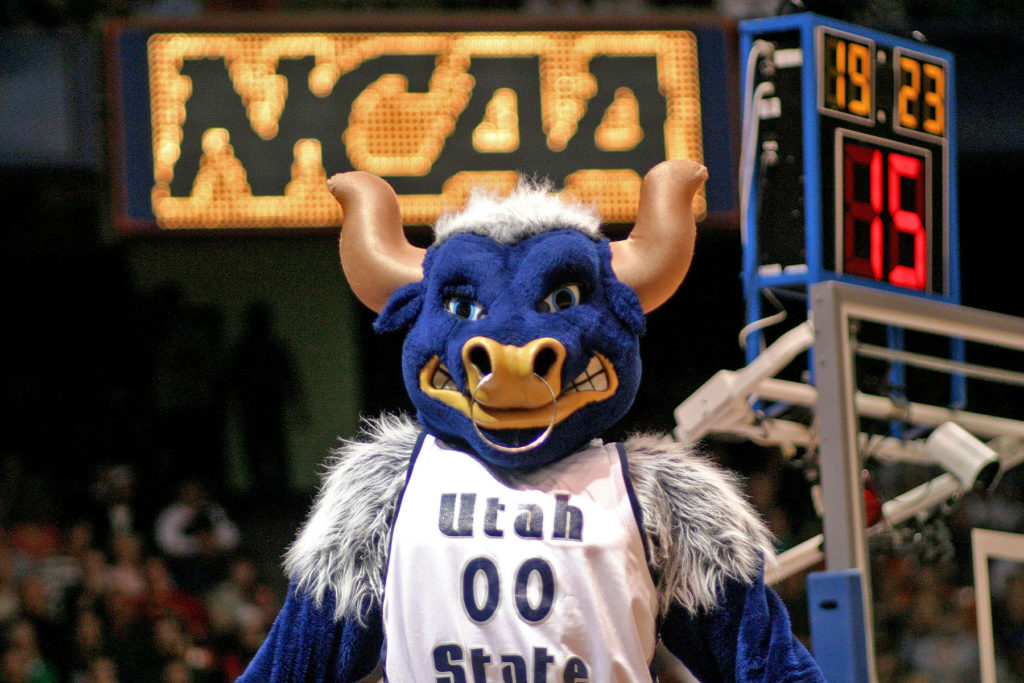
“I do their laundry, and sometimes I gag — sometimes I don’t — but they are drenched,” says Morgan Watts, a former cheerleader and Aggiette who took over as USU Spirit Squad advisor in the spring of 2020. “We’ve weighed our student who wears the suit before and after, and the average water weight that they lose is like 8-9 pounds every game.”
Former Big Blue Kaleb Redden used to wake up early on game days just to consume extra carbs for energy, especially for an early season football game when he would easily sweat out 10 pounds of water weight in the warm weather. Then he’d drink as much Gatorade as possible during halftime to stay hydrated.
“I was always completely exhausted after every game,” says Redden, who initially came to USU to play football before suffering a back injury. “By the end, I’d feel like I had just sprinted a 5K or something because my legs and lungs would be on fire from racing up and down the stairs in the stadium or the Spectrum. It was pretty tough. I can remember my quads being pretty lit up after games.”
At the time Redden was on the spirit squad, the team used to stay after basketball games and clean the Spectrum as a fundraiser. Zimmerman would provide pizza on those nights, and she always made certain to get an entire pie just for Big Blue.
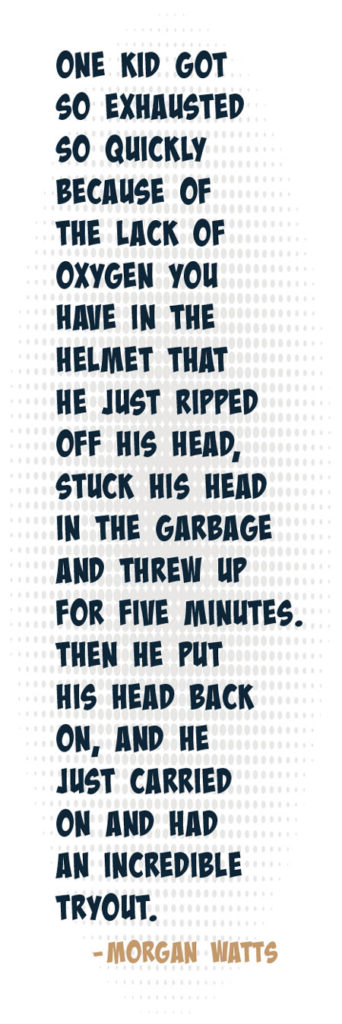
“Linda wanted to make sure that I refueled because I was always tanked,” Redden laughs. “I still can’t believe that. I don’t think there’s any way I could eat a whole pizza now.”
Despite the immense physical challenges of being Big Blue, there’s seemingly no shortage of individuals who want to don the head. While most use experience as a member of the spirit squad to become USU’s mascot, some Blues come completely, well, out of the blue with no cheerleading experience.
Tryouts are held each spring, and they’ve become the stuff of legend. Unlike cheerleaders and Aggiettes, who receive half scholarships, Big Blues are given a full scholarship, so the competition can get fierce — and fun — as participants perform skits, display their athletic skills, and attempt to navigate a series of potential scenarios like a scared child or a bad call while in front of a panel of judges.
“Sometimes it’s their first time in the suit, so it’s just brutal,” Watts says. “This year, one kid got so exhausted so quickly because of the lack of oxygen you have in the helmet that he just ripped off his head, stuck his head in the garbage and threw up for five minutes. Then he put his head back on, and he just carried on and had an incredible tryout.”
Jordan Rampersad displayed similar determination during his tryout. Now in his seventh year as an assistant coach for the spirit squad, Rampersad ran out of the tunnel at the Spectrum and immediately went into a tumbling pass, but he “landed weird,” according to Zimmerman. “I knew he was hurt … and he had a big bump on his arm, so I said we needed to get him to the ER. But Jordan said, ‘Nope, I’m finishing the auditions.’”
Part of the tryout included executing a Diamond Head formation, when Big Blue stands on the shoulders of a male cheerleader, while helping to hold up a female cheerleader with each arm. Miraculously, Rampersad ended up completing the stunt even though it turned out he had broken arm.
“He had to have surgery, and they put that rod and screws in his arm,” Zimmerman says, gesturing towards the photo and medical hardware on her office wall that Rampersad had framed and gave her as a gift. “When he made it back from the ER, he found he had made Big Blue. But he was out of commission for a couple of months after having surgery.”
Rampersad’s injury stands as the worst in Big Blue history, but considering the lack of vision inside of the head, it’s surprising that there haven’t been more painful miscues. Big Blue’s primary source of sight comes through the head’s two nostrils and a horizontal slit at the mouth. But even then, the mascot can’t see his feet.
“I always had a lot of anxiety about running over a small child, especially when we would visit elementary schools and play with them on the playground,” former Big Blue Tom Davis says. “And then there’s that darn tail. Kids just love to grab it, and with some of them, it didn’t matter what you did, they would just not let go of that tail. So, you would just have to come to the decision that they you weren’t going anywhere until they got bored.”
One notable fan of Big Blue is John Hartwell, USU’s athletic director. He has been around collegiate athletics nearly all of his life, and he recognizes when a mascot successfully walks the line between being easy for children to love, but also displaying strength at the same time.
“A lot of places wrestle with this with their mascot: is it tough enough, and yet, kid-friendly enough of a mascot? And I really think that Big Blue satisfies both of those silos,” Hartwell declares. “Our fan base certainly knows Big Blue. And I would also say this: the students who are behind Big Blue do a great job. Their training is great, and they do a great job interacting with young kids, while at the same time generating spirit for our fans in the stands.”
One thing that donning the Big Blue costume affords, however, is anonymity. Utah State’s mascot doesn’t speak, and he does everything he can to keep his identity a secret until he finally removes his head in front of the crowd at the Spectrum at the end of his senior year. And some of the Blues have used that opportunity to overcome some personal fears. Bo Roundy, who was Big Blue from 2001- 05, even wrote a children’s book about his experiences titled My Friend Big Blue.
“Bo didn’t like being in front of crowds; it really gave him anxiety,” Zimmerman remembers. “So, I talked to him and said, ‘What do you think about Big Blue, because then you would be out there but no one would know it was you.’ And that changed his life so much. He’s now a schoolteacher and a coach and always out in front of students. He’ll tell that being Big Blue really helped him.”
But one personality trait that Zimmerman says all of the Big Blues have shared is: “They’re all just a little crazy.”
“They’re fearless, they’re go-getters and they’re not afraid of anything,” Zimmerman adds.
After being around numerous Big Blues both as an advisor and a teammate, Watts says the same thing.
“They are crazy, high-energy people, who, when they get hurt, act like it’s no big deal, and just want to keep going even if they’re bleeding. It’s a personality trait they all have that, I’m fine, just let me go just do another back flip or jump off this or that.”
A “Little Brawl”
On March 13, 2009, the Utah State men’s basketball team was on the ropes. Going up against rival New Mexico State in the semifinals of the Western Athletic Conference tournament in Reno, Nevada, the 28-win Aggies found themselves trailing NMSU by 13 points at halftime. But USU head coach Stew Morrill encouraged his team to chip away at the New Mags’ lead, and with just over seven seconds left and USU trailing by just one point, forward Tai Wesley put up a short hook shot.
The potential game-winner was off the mark, but while attempting to corral the rebound, the ball went off a New Mexico State player and out of bounds. That led to Morrill calling timeout to set up a play, one that resulted in USU’s Tyler Newbold knocking down a 15-foot jumper for the go-ahead basket in USU’s 71-70 comeback victory.
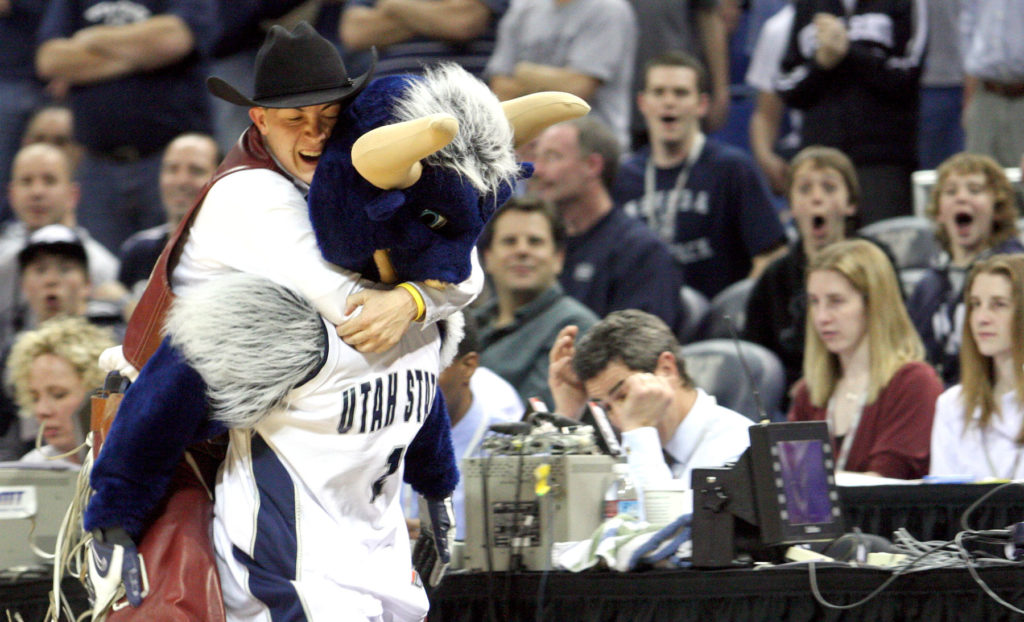
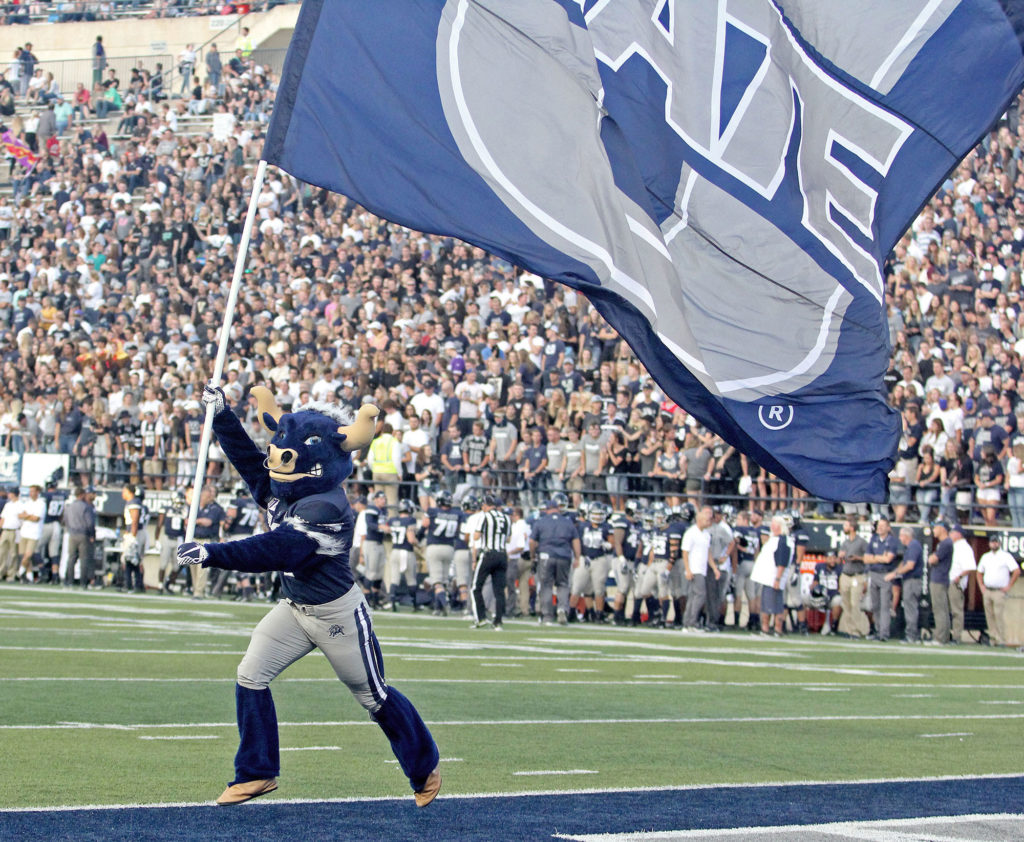
Had NMSU secured the rebound on Wesley’s miss, the New Mags would have very likely beaten the Aggies, denying Morrill’s team a spot in the championship game—which they won the next night—and possibly an appearance in the NCAA Tournament. But it also would have made Linda Zimmerman’s life much easier because of what happened during the timeout. And even 12 years later, Zimmerman still struggles to discuss the incident that brought recognition to Big Blue around the country, for all the wrong reasons.
“That was not a fun experience,” Zimmerman laments. “But you know, they’re college students and learn a lot while they’re here, good and bad, right?”
During the game, a fan offered $100 to Big Blue if he would pull off the huge, fake mustache off of the face of NMSU’s mascot, Pistol Pete, a cowboy. First-year student Caleb Morrison was serving as Blue for that game, and USU’s final timeout created the opportunity for him to collect the bounty. But after removing Pistol Pete’s mustache and tossing it aside, Morrison was walking along the edge of the court when Pistol Pete, understandably annoyed, charged from behind and jumped on Big Blue’s back.
“I didn’t see him pull the mustache off, I just saw the little brawl after Pistol Pete came and jumped on him,” Zimmerman recalls. “And I was like, What the heck?”
Morgan Watts, a cheerleader at the time, had a similar reaction to the fracas televised around the country.
“I was sitting right there, and I was like, Oh my gosh!’ Although I probably said some words out loud because we were just in shock,” Watts says. “The cowboy was crazy, but how (Morrison) reacted once he put him in a chokehold was perfect.”
Big Blue somehow managed to stay upright and keep his head on during the clash, and once he got Pistol Pete off his back, simply shrugged and acted like he had no idea why the cowboy attacked him from behind. However, Morrison’s counterpart, Kaleb Redden, literally had his teammate’s back.
“Thankfully, no one really saw this, but I jumped out of the stands as soon as I saw what was happening,” the musclebound Redden says. “I was a bouncer in college, so I was pretty good at understanding when people had ill intentions. … I just tried to make sure they were separated.”
“But it was funny, most of my close friends knew I was Big Blue by that time, and they said, ‘We knew right away that wasn’t you in the suit because you would have laid that guy out,’” Redden adds.
He was, however, affected by fallout from the incident. Because of Morrison’s bounty grab, Big Blue—the mascot—was suspended for the next day’s championship game against Nevada. So, even though Redden wasn’t the technically the mascot who took the mustache, he wasn’t able to wear the Big Blue suit during the Aggies’ win over the Wolfpack. Redden was allowed to dress as a cheerleader, and he later donned the costume one more time during USU’s NCAA Tournament game against Marquette.
The $100 that led to all the trouble was donated to an organization in Reno where the spirit squad had been earlier in the week for a service project, while Morrison soon left on a church mission, only to return to the Big Blue costume after he got back home.
“That was kind of embarrassing, leaving a mark on the institution like that,” Zimmerman says. “But it was a learning experience, and I think (Morrison) learned a lot, went on a mission then came home, was Big Blue again and was great. I think he grew up a lot.
“And at least the $100 donation was good, right?”
From the Rafters
Big Blue has had his share of heartache, too.
Betty Blue, his “girlfriend,” was basically just a Big Blue costume filled out with a broomstick and some Styrofoam and topped off with a wig. Mere weeks after being introduced to Aggie fans, she disappeared. During a 2002 home game against the Cougars, Big Blue and the spirit squad used Betty in some routines, and then lovingly placed her amongst the squad’s equipment. But at the end of the game, she was nowhere to be found. An investigation turned up an eyewitness who said they had seen Betty’s wig bouncing up and down in the crowd exiting Romney Stadium.

Rather than rage against the likelihood that Betty Blue had been snatched by BYU fans, Zimmerman and the spirit squad embraced the situation, creating a “Where’s Betty” campaign and making a video showing a devastated Big Blue searching for her all over campus.
Betty was “udderly beautiful,” Big Blue was quoted as saying, while also expressing concern that Betty Blue might have wooed away by Cosmo.
A few weeks after her disappearance, Betty was finally found in Provo. Campus police at BYU spotted a couple of people on top of a pedestrian overpass in the middle of the night, and after the individuals ran off, discovered Betty Blue with a rope around her waist, apparently about to be dangled off the bridge.
A Utah State police officer drove to Provo to retrieve Betty, who was then triumphantly re-introduced to USU fans while sitting in a wheelchair at a basketball game in the Spectrum.
“We still don’t know if it was a BYU person who stole her and took her back, or it was a Utah State person playing a joke and trying to blame it on BYU,” Zimmerman says. “We had a lot of fun with that.”
A few years after Betty Blue was found tied up, Big Blue started spending a little time attached to a rope himself.
Around 2004, Bo Roundy started a new pre-basketball game tradition of having Big Blue rappel down to the Spectrum floor from above the scoreboard hanging over the court. Roundy’s spirit squad teammate and future Big Blue, Tom Davis, was a rock climber and helped put together the setup that made for one of the most spectacular entrances in college athletics for years.
“Personally, I don’t think anything hyped up the Spectrum more than Blue rappelling from the ceiling,” Watts says. “If we knew that would be 100 percent safe, I would go back to that in a heartbeat. … But there’s so much liability involved; I’m honestly shocked it went on as long as it did.”
While no Big Blue ever fell in front of a Spectrum crowd during the rappel period, Redden very nearly got hung up about halfway down during a pre-game rappel but miraculously felt a knot in the rope just before it became wedged in his Figure 8 descender.
“That would have been disastrous because I would have been stuck there … and they would have had to go get a ladder or something to get me down,” Redden says. “It was sheer luck that I felt it because I couldn’t see anything in the helmet. But I was able to pull it up into my lap and fumbled my around until I could get it untied and then drop the rope.
“I remember they had to wait for me to get down, and Linda was sweating bullets.”
That was not unusual, however.
“I haven’t lost a night’s sleep since the installed the new Jumbotron,” Zimmerman says of the scoreboard addition that helped bring an end to Big Blue’s rappelling days.
Some ambitious souls briefly toyed with the idea of Big Blue bungee jumping from the ceiling, and even tried it out a few times, she says, “but it was just too dangerous, so we cut it.” And they also looked into having Blue zipline from above a tunnel at the Spectrum down to the court, as well as from a light standard at Maverik Stadium. But the effect simply wasn’t spectacular enough, and the zipline idea was scrapped, leaving USU’s mascot primarily earthbound.
But at least one Blue made the most of the opportunity when he could. Ted Kyriopoulos, who served as Big Blue during the 2007-08 school year, admits that for a first date, he once snuck into an empty Spectrum at night, and rigged the ropes so they could both drop out of the scoreboard.
“She had never rappelled before, so she was a little nervous. But it all worked out,” declares Kyriopoulos, who has been married to that adventurous young woman, former USU women’s basketball player Ana Pares, for the past 12 years.
Blue Bloods
While Big Blue’s job is to help add to the enjoyment of Aggie athletics contests and other USU events, it’s clear that for those involved with Utah State’s mascot—especially those who have actually spent time in the head—there’s an awful lot of appreciation for the opportunity to share in the history.
“It’s a humbling experience and an honor to be in the shadow of so many great people,” says Tom Davis, who spent three years as Big Blue and is now a pilot for SkyWest Airlines. “They’ve really shined in their lives, and I look at them as great friends and mentors. It’s humbling to even be considered a quasi-part of who they are, and what they created as Big Blue.”
Ted Kyriopoulos, who has flown helicopters and large jets for the Navy for the past 13 years, never envisioned being a part of the USU Spirit Squad, much less the putting on Big Blue’s suit when he was playing football and wrestling in high school. But he loved his year as Utah State’s mascot primarily because of two things: the opportunity to make children happy and crowd surf in the student section.
“The best part of the job was interacting with kids, and the second-best thing was the fans,” Kyriopoulos proclaims. “Some kids got scared, but I think I made a lot of kids happy. They made it fun. But it was also fun being able to crowd surf like you were a rock star. That’s something that I never would have been able to experience without the costume.”
For Redden, his stint as Big Blue clearly serves as a lifetime highlight, which is a lot coming from a man who bears an uncanny resemble to Chris Hemsworth of Thor fame, and who displayed his strength and athleticism on the TV show The Titan Games in front of celebrity host Dwayne “The Rock” Johnson. Not to mention Redden is also a dedicated physician based in Boise, Idaho, who has been on the front lines of the fight against COVID-19 since the start of the pandemic.
But when he looks back at opportunities he had to visit elementary schools, nursing homes and sick children in hospitals while dressed as Big Blue, it’s clear that those moments helped steer the Big Piney, Wyoming, native towards his current vocation.
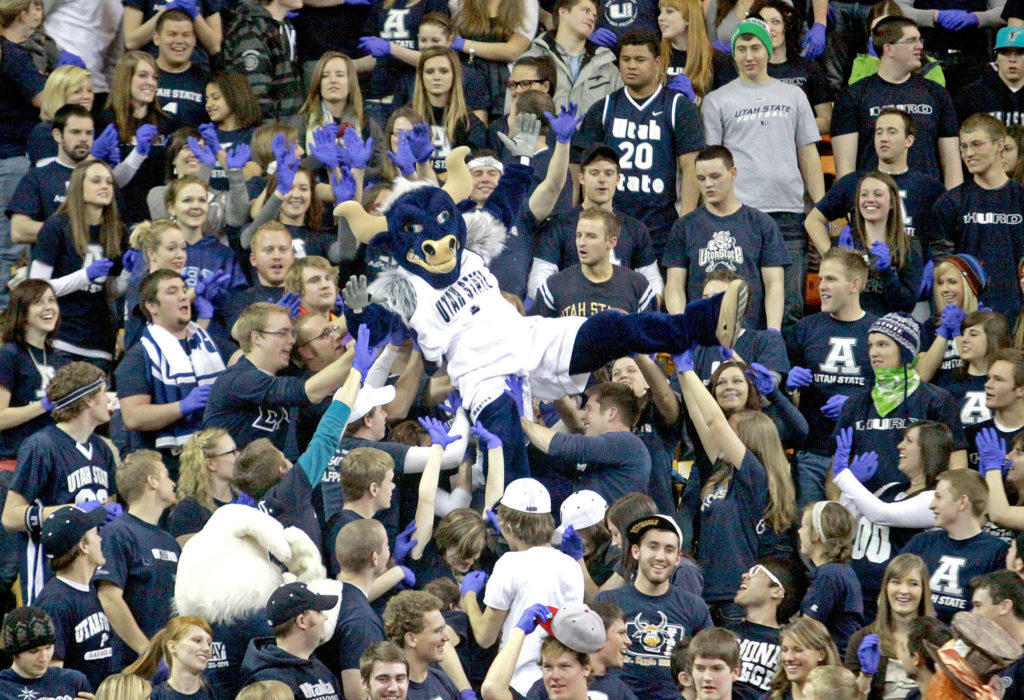
“It was so touching to see them light up when Big Blue came to spend time with them. It wasn’t me; it was Big Blue. But it felt so good to be able to give that gift and not receive any praise other than just the smiles on those people’s faces,” Redden states in the middle of a short break during another long hospital shift. “I’ve never had an opportunity like that since …
“It’s not something that I think about that often — and I’m not an overly emotional person — but this is kind of bringing tears to my eyes thinking back to those experiences because it was so unique. I will never get an opportunity to do that type of stuff ever again, to be able to give like that.”
Redden pauses a moment and then adds, “There’s so much that you gain from giving of your time and your talents, and being Big Blue really taught me that lesson with firm conviction. And I would say that that’s the thing that I look back at with the most fondness is the opportunity to learn as a human being a love for humanity.”
By Jeff Hunter ’96
Opening image of Big Blue in the shadows by Levi Sim.






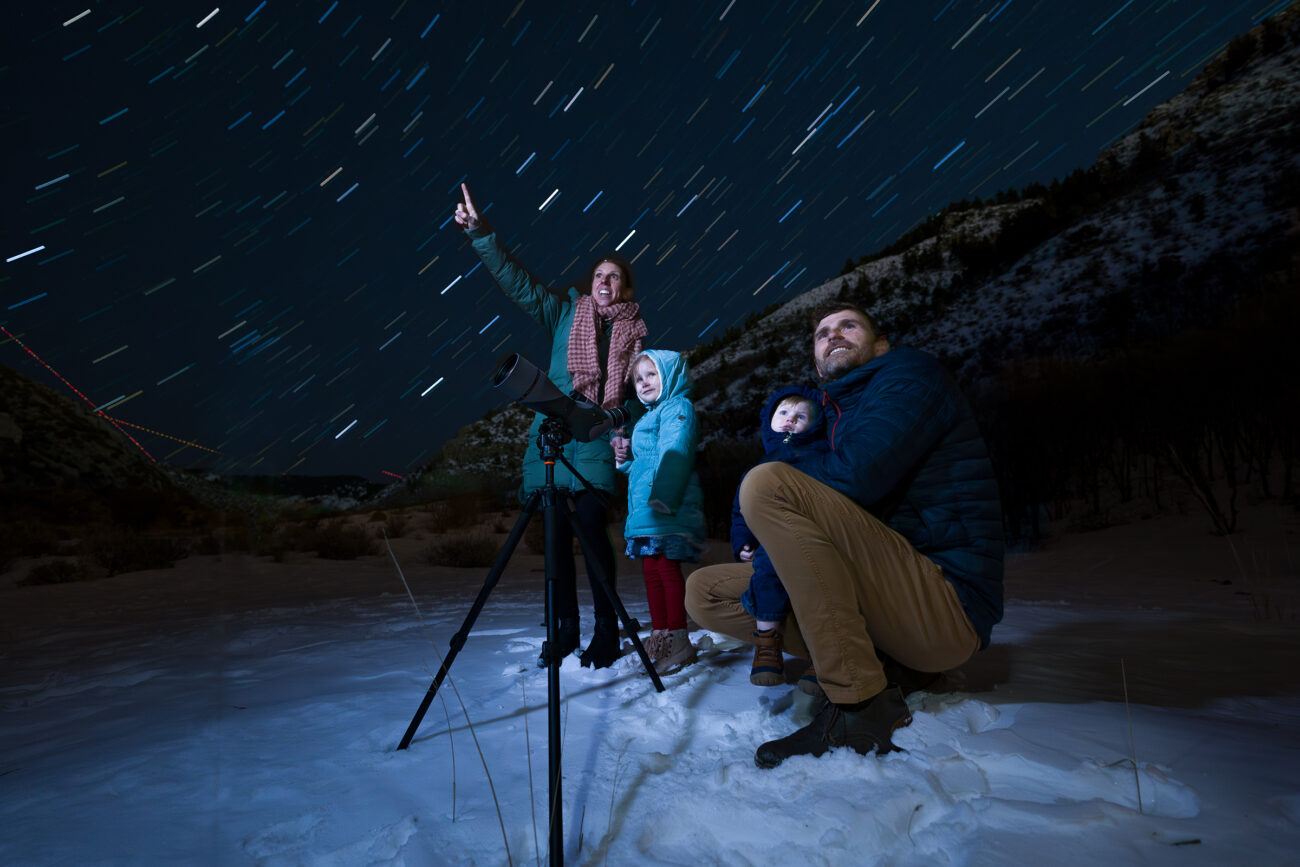
LuWana Hunt January 14, 2022
Great article!!! Thanks for helping us relive so many memories with USU sports and especially Big Blue♥️